Mites and poultry lice are a natural part of every backyard- they travel on birds, rodents and other animals, so when your chickens become infested, it doesn’t mean you’re not keeping a clean coop, it simply means your chickens enjoy the Great Outdoors! Being able to identify each type external parasite is not important, but the ability to recognize the signs and symptoms of an infestation and how to treat them is.
Bielefelder hen.
The following information may make you itch, but not knowing how to treat mites and lice effectively can have devastating consequences for chickens.
Some of the common signs of any type of mite or lice infestation in a chicken are: dirty-looking vent feathers, decreased activity or listlessness, a pale comb, changes in appetite, a drop in egg production, weight loss, feather-pulling, bald spots, redness or scabs on the skin, dull, ragged-looking feathers, crawling bugs on a chicken’s skin or nits on feathers.
COMMON EXTERNAL PARASITES in CHICKENS:
The two most common categories of external parasites in chickens are mites and poultry lice. Poultry lice are NOT the same as human head lice and people cannot contract lice from chickens.
MITES
Northern fowl mites and Red Roost Mites are two of the most common poultry mites. These tiny, eight-legged beasts can live both on the chicken and in the coop. Red roost mites are partial to cracks and crevices in wood, roosts and inside nesting boxes.
Mites can be grey, dark brown or reddish in color and can often be seen along feather shafts and underneath roosts after dark. Red roost mites are active at night when they venture out to leech blood from chickens. With its moist, rich blood supply, the vent area is a favorite feeding ground of mites.
(Northern fowl mite)
Mites on feather shafts and chicken’s skin
Typical signs of a mite infestation are scabs near the vent, eggs on the feathers and feather shafts and a light colored bird’s feathers may appear dirty in spots where the mites have left droppings and debris. A heavy mite infestation can lead to anemia and death of a chicken. Mites will bite humans, causing minor irritation in the affected area (and an urgent desire to take a gasoline shower).
(Lice eggs (nits) on feather shafts)
SCALY LEG MITES
Another common mite is the scaly leg mite, (Knemidokoptes mutans) which I discuss in detail here.
POULTRY LICE
Poultry lice are fast-moving, 6 legged, flat insects with round heads that live only on the chicken and its feathers. They are beige or straw colored and are typically found at the base of feather shafts near the vent. Poultry lice feed on dead skin and other debris such as feather quill casings. When parting the feathers near the vent to inspect for parasites, they can be seen briefly as they run away. The eggs laid by the female are seen at the bases of feather shafts.
New poultry lice infestation detected early. Note the absence of nits or debris on the feather shafts.
Poultry lice scurrying around the vent of a hen.
Chickens dust bathing
PREVENTION
Mites and lice are most commonly brought into chicken yards by wildlife, especially by wild birds. The use of best biosecurity practices, regular inspections, and vigilant observation will limit the damage they inflict.
- Clean coops regularly, disposing of loose feathers that can carry hatching eggs (nits).
- Limit visits from fellow poultry-keepers who can transport the creepy crawlies on their clothes, footwear or equipment, (vehicles, shared farm equipment, etc.).
- Do not attract wildlife to the chicken yard with the use of wild bird feeders.
- Secure chicken feed to prevent parasite and disease-carrying wildlife from visiting regularly.
- Do not introduce chickens into an existing flock that you have not raised as baby chicks from an NPIP certified hatchery.
- Provide adequate dusting areas for chickens to care for their own skin and feather health.
Mites and lice will not be repelled by herbs of any kind.
Never use food grade diatomaceous earth with chickens in any way. It is not an effective insecticide and is hazardous to hen health as well as being a known carcinogen in humans.
Never use food grade diatomaceous earth with chickens in any way. It is not an effective insecticide and is hazardous to hen health as well as being a known carcinogen in humans.
I NEVER use and do not recommend food grade diatomaceous earth for any purpose with chickens. A dust bath should never include food grade diatomaceous earth nor any other additive! Good sanitation practices, frequent flock inspections and providing ample access to sand for dust bathing are sufficient preventative measures without exposing the chickens or humans to the ever-present exposure to a carcinogenic respiratory hazard.
This Facebook follower of mine had to have her hen put to sleep from a severe mite infestation that she had been trying to control with DE, aka: food grade diatomaceous earth, which failed to work, predictably.
LICE & MITES TREATMENT
When lice or mites are found on one bird, the entire flock and coop must be treated. There are many different products available to eradicate mites and lice with varying degrees of effectiveness and safety, among them are:
- Elector® PSP
- Davis Pure Planet Poultry Spray
- Garden & Poultry Dust with Permethrin
- Prozap Garden & Poultry Dust
- Dog flea dips, flea shampoos (for temporary relief only)
**Treatment for lice and mites with most products must be repeated twice after the initial application in 7 day increments, in order to kill the eggs (nits) that had not hatched at the time of the previous treatments. This does not apply to Elector PSP, which is a one time application.**
Rotate treatment products to prevent the development of resistance by parasites (this does not apply to Elector PSP). With all methods except Elector PSP, the entire coop must be cleaned out and treated with particular attention paid to nests and roosts. With Elector PSP, the building can be treated directly with the birds inside it, but the presence of parasites is a good reason to clean out the coop anyway.
8 oz Elector PSP bottle
Elector PSP can be purchased in 8 oz bottles online for approximately $160.00. I offer Elector PSP in 9 ml bottles for small flocks HERE.
By far, my preferred treatment for lice and mites is poultry veterinarian recommended Elector® PSP . The active ingredient is Spinosad , a product of the fermentation of Saccharopolyspora bacteria. Elector PSP has NO EGG withdrawal period!
Spray in cleaned, empty coop and on birds at the rate of 9 ml per gallon of water. Always mix a fresh batch for each use.”Spinosad (fermentation product of Saccharopolyspora, a type of bacteria). Single use controls all stages of mites. Also kills flies, beetles, agricultural insect pests. Can be used directly on laying hens and to spray buildings.”* Elector PSP can be purchased HERE.
This video shows Mr. Chicken Chick & I treating three of my hens for mites with Elector PSP.
This video explains HOW Elector PSP works. Read more information about Elector PSP HERE.
ABOUT Elector PSP
Poultry veterinarian recommended Elector PSP is the most effective, safest, easiest solution to eradicating mites and lice in your flock with NO egg WITHDRAWAL period! Elector is safe for humans and your pet chickens. Due to its multiple mechanisms of action, mites and lice do not develop resistance to it. Elector PSP, in the spinosyn class of insecticides, acts as both a larvicide and an adulticide, killing adults and their nits after ONE application when used properly.
This terrific video explains HOW Elector PSP works. Given the mechanisms of action as described in the video, it can take a day or two for full effectiveness.
TO USE Elector PSP:
Treating birds after dark when they have gone to roost is the easiest way to handle the entire flock while minimizing stress and without having to chase anyone. It’s best to tackle the job with a partner.
Dilute 9 ml of Elector PSP in one gallon of water. Shake well before and frequently during use. Add solution to a spray bottle to apply to all flock members, paying particular attention to the feathers and skin around the vents and crests of crested breeds.
If treating for red roost mites, spray the coop, paying particular attention to crevices.
Prepare solution fresh for every application. Follow manufacturer’s instructions for disposal of unused portion.
VIDEO of Mr. Chicken Chick and me treating our flock with Elector PSP at this link.
Read more about Elector PSP HERE. Elector PSP Product Label.
If using a dust product, while wearing a respirator, gloves, and protective eyewear, dust underneath the wings and vent area of each bird sparingly but thoroughly.
An extensive list of treatment options (with application rates) for eradicating poultry pests including, lice, mites and fleas, can be found at this link to the Mississippi State University Extension Service.
Sources & further reading:
http://edis.ifas.ufl.edu/ig140
Herbal Pest Management, Susan Burek, Herbalist BackyardPoultry Magazine June/July 2011
A Personal Perspective on using DE, Herbalist Susan Burek
List of herbs good for pastured animals.
The Dirt on Diatomaceous Earth, Shagbark Farms
Mites of Poultry, The Merck Veterinary Manual
*External & Internal Parasites of Poultry, Eva Wallner-Pendleton, DVM, MS, ACPV
Pesticides Used for Control of Poultry Insect Pests
Kathy Shea Mormino
Affectionately known internationally as The Chicken Chick®, Kathy Shea Mormino shares a fun-loving, informative style to raising backyard chickens. …Read on


shop my SPONSORS
Mites and poultry lice are a natural part of every backyard- they travel on birds, rodents and other animals, so when your chickens become infested, it doesn’t mean you’re not keeping a clean coop, it simply means your chickens enjoy the Great Outdoors! Being able to identify each type external parasite is not important, but the ability to recognize the signs and symptoms of an infestation and how to treat them is.
Bielefelder hen.
The following information may make you itch, but not knowing how to treat mites and lice effectively can have devastating consequences for chickens.
Some of the common signs of any type of mite or lice infestation in a chicken are: dirty-looking vent feathers, decreased activity or listlessness, a pale comb, changes in appetite, a drop in egg production, weight loss, feather-pulling, bald spots, redness or scabs on the skin, dull, ragged-looking feathers, crawling bugs on a chicken’s skin or nits on feathers.
COMMON EXTERNAL PARASITES in CHICKENS:
The two most common categories of external parasites in chickens are mites and poultry lice. Poultry lice are NOT the same as human head lice and people cannot contract lice from chickens.
MITES
Northern fowl mites and Red Roost Mites are two of the most common poultry mites. These tiny, eight-legged beasts can live both on the chicken and in the coop. Red roost mites are partial to cracks and crevices in wood, roosts and inside nesting boxes.
Mites can be grey, dark brown or reddish in color and can often be seen along feather shafts and underneath roosts after dark. Red roost mites are active at night when they venture out to leech blood from chickens. With its moist, rich blood supply, the vent area is a favorite feeding ground of mites.
(Northern fowl mite)
Mites on feather shafts and chicken’s skin
Typical signs of a mite infestation are scabs near the vent, eggs on the feathers and feather shafts and a light colored bird’s feathers may appear dirty in spots where the mites have left droppings and debris. A heavy mite infestation can lead to anemia and death of a chicken. Mites will bite humans, causing minor irritation in the affected area (and an urgent desire to take a gasoline shower).
(Lice eggs (nits) on feather shafts)
SCALY LEG MITES
Another common mite is the scaly leg mite, (Knemidokoptes mutans) which I discuss in detail here.
POULTRY LICE
Poultry lice are fast-moving, 6 legged, flat insects with round heads that live only on the chicken and its feathers. They are beige or straw colored and are typically found at the base of feather shafts near the vent. Poultry lice feed on dead skin and other debris such as feather quill casings. When parting the feathers near the vent to inspect for parasites, they can be seen briefly as they run away. The eggs laid by the female are seen at the bases of feather shafts.
New poultry lice infestation detected early. Note the absence of nits or debris on the feather shafts.
Poultry lice scurrying around the vent of a hen.
Chickens dust bathing
PREVENTION
Mites and lice are most commonly brought into chicken yards by wildlife, especially by wild birds. The use of best biosecurity practices, regular inspections, and vigilant observation will limit the damage they inflict.
- Clean coops regularly, disposing of loose feathers that can carry hatching eggs (nits).
- Limit visits from fellow poultry-keepers who can transport the creepy crawlies on their clothes, footwear or equipment, (vehicles, shared farm equipment, etc.).
- Do not attract wildlife to the chicken yard with the use of wild bird feeders.
- Secure chicken feed to prevent parasite and disease-carrying wildlife from visiting regularly.
- Do not introduce chickens into an existing flock that you have not raised as baby chicks from an NPIP certified hatchery.
- Provide adequate dusting areas for chickens to care for their own skin and feather health.
Mites and lice will not be repelled by herbs of any kind.
Never use food grade diatomaceous earth with chickens in any way. It is not an effective insecticide and is hazardous to hen health as well as being a known carcinogen in humans.
Never use food grade diatomaceous earth with chickens in any way. It is not an effective insecticide and is hazardous to hen health as well as being a known carcinogen in humans.
I NEVER use and do not recommend food grade diatomaceous earth for any purpose with chickens. A dust bath should never include food grade diatomaceous earth nor any other additive! Good sanitation practices, frequent flock inspections and providing ample access to sand for dust bathing are sufficient preventative measures without exposing the chickens or humans to the ever-present exposure to a carcinogenic respiratory hazard.
This Facebook follower of mine had to have her hen put to sleep from a severe mite infestation that she had been trying to control with DE, aka: food grade diatomaceous earth, which failed to work, predictably.
LICE & MITES TREATMENT
When lice or mites are found on one bird, the entire flock and coop must be treated. There are many different products available to eradicate mites and lice with varying degrees of effectiveness and safety, among them are:
- Elector® PSP
- Davis Pure Planet Poultry Spray
- Garden & Poultry Dust with Permethrin
- Prozap Garden & Poultry Dust
- Dog flea dips, flea shampoos (for temporary relief only)
**Treatment for lice and mites with most products must be repeated twice after the initial application in 7 day increments, in order to kill the eggs (nits) that had not hatched at the time of the previous treatments. This does not apply to Elector PSP, which is a one time application.**
Rotate treatment products to prevent the development of resistance by parasites (this does not apply to Elector PSP). With all methods except Elector PSP, the entire coop must be cleaned out and treated with particular attention paid to nests and roosts. With Elector PSP, the building can be treated directly with the birds inside it, but the presence of parasites is a good reason to clean out the coop anyway.
8 oz Elector PSP bottle
Elector PSP can be purchased in 8 oz bottles online for approximately $160.00. I offer Elector PSP in 9 ml bottles for small flocks HERE.
By far, my preferred treatment for lice and mites is poultry veterinarian recommended Elector® PSP . The active ingredient is Spinosad , a product of the fermentation of Saccharopolyspora bacteria. Elector PSP has NO EGG withdrawal period!
Spray in cleaned, empty coop and on birds at the rate of 9 ml per gallon of water. Always mix a fresh batch for each use.”Spinosad (fermentation product of Saccharopolyspora, a type of bacteria). Single use controls all stages of mites. Also kills flies, beetles, agricultural insect pests. Can be used directly on laying hens and to spray buildings.”* Elector PSP can be purchased HERE.
This video shows Mr. Chicken Chick & I treating three of my hens for mites with Elector PSP.
This video explains HOW Elector PSP works. Read more information about Elector PSP HERE.
ABOUT Elector PSP
Poultry veterinarian recommended Elector PSP is the most effective, safest, easiest solution to eradicating mites and lice in your flock with NO egg WITHDRAWAL period! Elector is safe for humans and your pet chickens. Due to its multiple mechanisms of action, mites and lice do not develop resistance to it. Elector PSP, in the spinosyn class of insecticides, acts as both a larvicide and an adulticide, killing adults and their nits after ONE application when used properly.
This terrific video explains HOW Elector PSP works. Given the mechanisms of action as described in the video, it can take a day or two for full effectiveness.
TO USE Elector PSP:
Treating birds after dark when they have gone to roost is the easiest way to handle the entire flock while minimizing stress and without having to chase anyone. It’s best to tackle the job with a partner.
Dilute 9 ml of Elector PSP in one gallon of water. Shake well before and frequently during use. Add solution to a spray bottle to apply to all flock members, paying particular attention to the feathers and skin around the vents and crests of crested breeds.
If treating for red roost mites, spray the coop, paying particular attention to crevices.
Prepare solution fresh for every application. Follow manufacturer’s instructions for disposal of unused portion.
VIDEO of Mr. Chicken Chick and me treating our flock with Elector PSP at this link.
Read more about Elector PSP HERE. Elector PSP Product Label.
If using a dust product, while wearing a respirator, gloves, and protective eyewear, dust underneath the wings and vent area of each bird sparingly but thoroughly.
An extensive list of treatment options (with application rates) for eradicating poultry pests including, lice, mites and fleas, can be found at this link to the Mississippi State University Extension Service.
Sources & further reading:
http://edis.ifas.ufl.edu/ig140
Herbal Pest Management, Susan Burek, Herbalist BackyardPoultry Magazine June/July 2011
A Personal Perspective on using DE, Herbalist Susan Burek
List of herbs good for pastured animals.
The Dirt on Diatomaceous Earth, Shagbark Farms
Mites of Poultry, The Merck Veterinary Manual
*External & Internal Parasites of Poultry, Eva Wallner-Pendleton, DVM, MS, ACPV
Pesticides Used for Control of Poultry Insect Pests




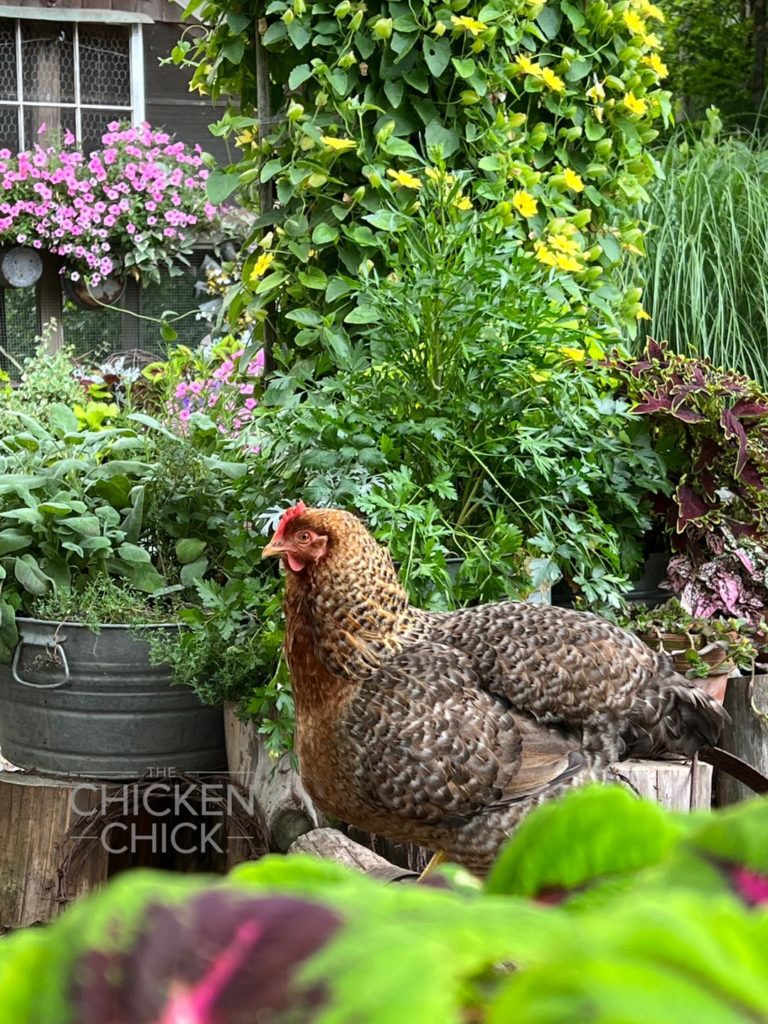
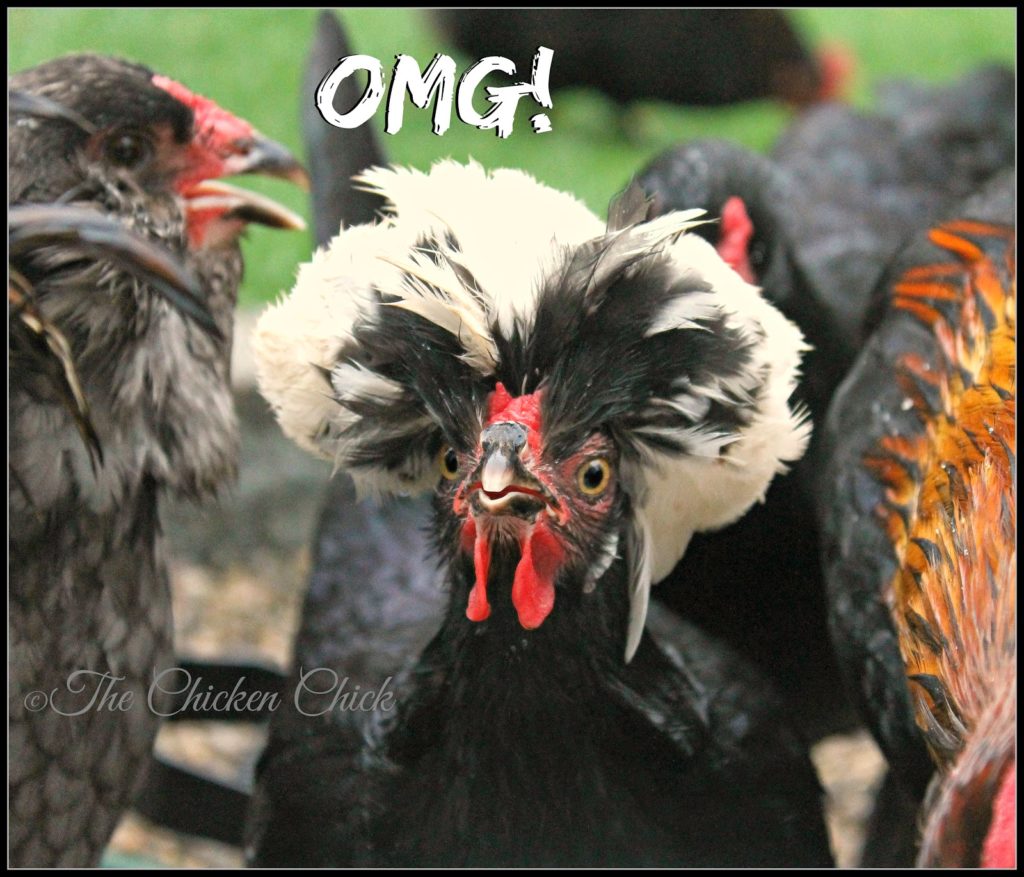
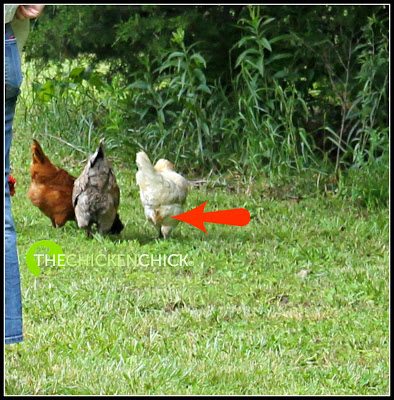
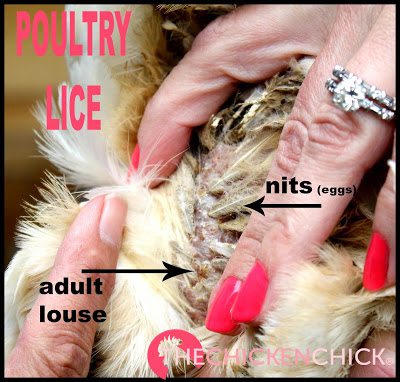
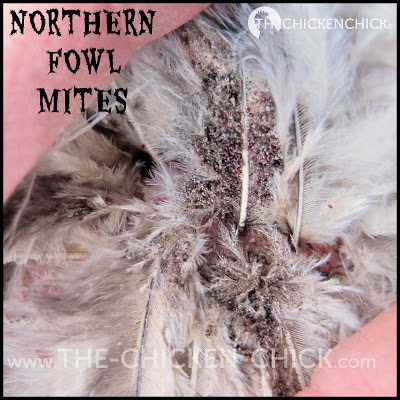
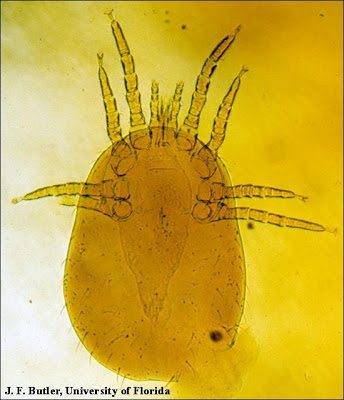
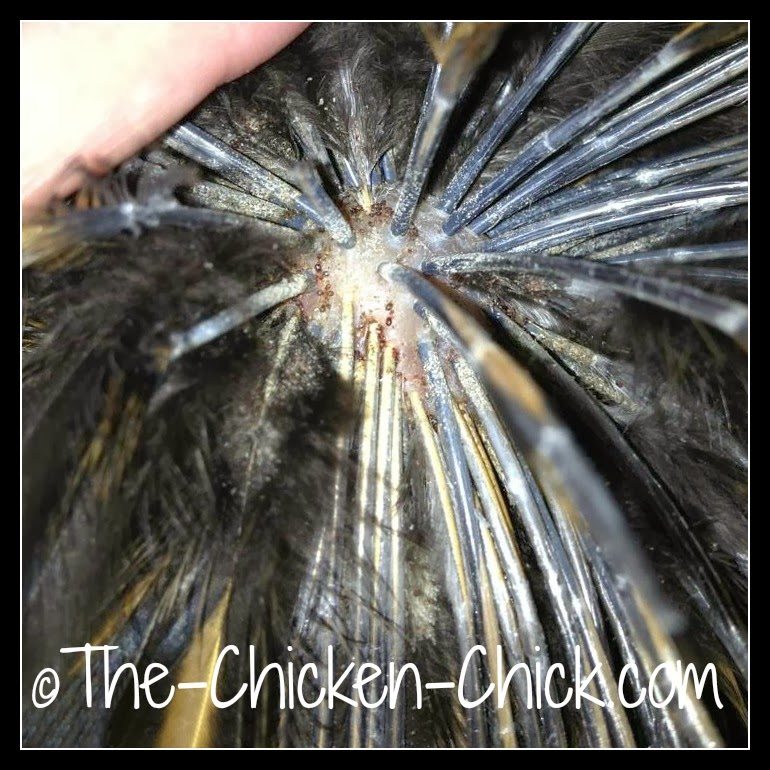
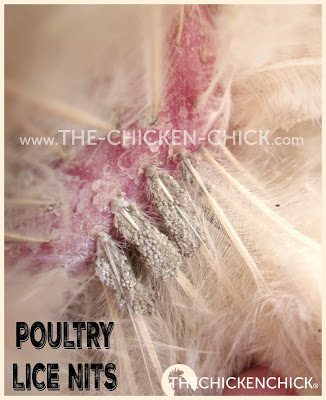
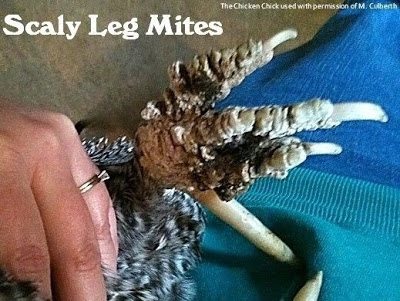
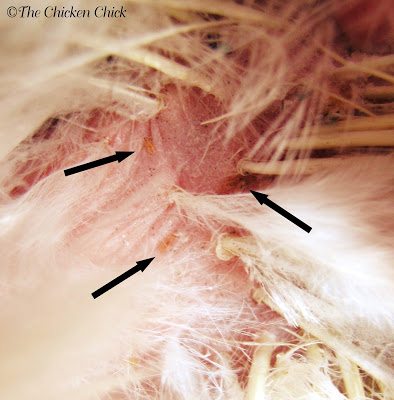
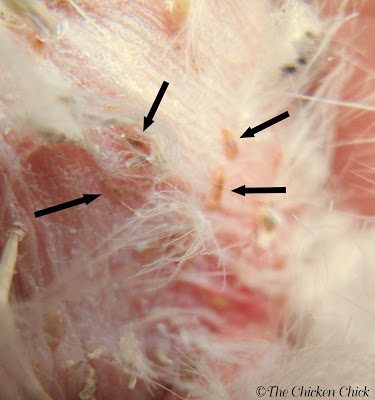
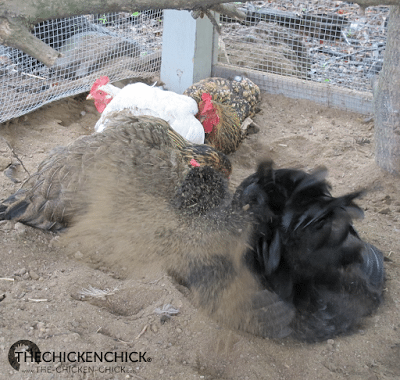

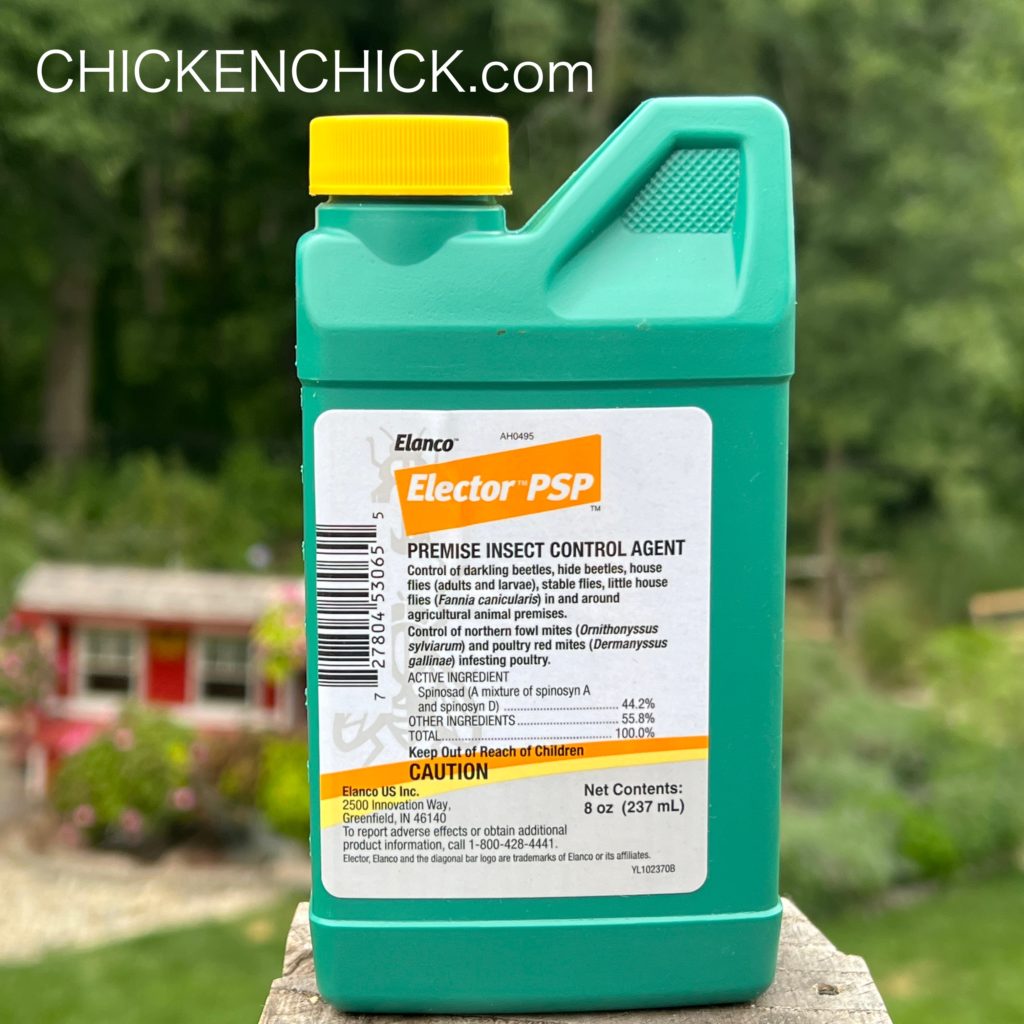

























My lavender Orpington has what looks like the poultry license. It’s exactly like the picture labeled that in this article. I have treated with Elector when I found some black mites on my other Orpington. And then I sprayed the coop. I’m not sure if the lice came after that initial spray, so should I treat the entire flock again? Also, do the feathers ever clean out? Should I give her a bath? I’ve been putting some powdered lime around the area and I think it’s helped but obviously I want to get rid of it.
One treatment is sufficient for both parasites. Don’t worry about any nits, they will be killed by the product.
Never not use lime around chickens, it’s not safe as they will ingest it, and it is completely unnecessary and not helpful in any way.
Do you get rd of all the sand in the coop if you find mites/lice?
If you do where does all that sand go?
No. Treat with Elector PSP
Every year my girls get mites. We treat with Elector PSP each time and they always come back. We’re treating each bird as well as cleaning out the coop and treating that as well. The last treatment we did was a little over 2 weeks ago and I noticed tonight that they’re back again. Help! I don’t know what I’m doing wrong 😭
What type of mites?
What are you using for litter?
Do you have any wild bird feeders in the chicken yard?
How are you mixing up the Elector PSP? What are you using for a sprayer?
I’m not quite sure what type they are. They’re gray in color when I see them crawling on my birds feathers at night and during the day I’ll occasionally see one on an egg that was laid. We use spine bedding
They do not sound like mites. I can’t tell you where the insects are coming from based on what you described.
No wild bird feeders on the property. Mixing PSP 9 ml/gallon. Spraying birds w/a small water bottle and the coop with a 2weed killer sprayer
I am devastated to see that my flock has lice ( 5 in a small coop) and mites- my large coop. The coops do not intermingle. That said I am a clean freak so I can’t imagine what happened.
My question is- my chickens free range every day. If I treat the coop and chickens with elector psp- do I need to do anything with the flower beds ? I mean they go everywhere! And with this treatment I only do it once? In 5 year of chickens I have never had this issue
You should not feel devastated- ALL outdoor animals are in contact with parasites. That is a normal part of being in nature, it is not a failing or an indication of a negligent chicken keeper. No, you do not need to treat anything other than the BIRDS once.
I just added 8 pullets to my already established flock of 5 hens and 1 rooster. 4 out 5 of the hens have feather loss on the lower back area and some messy feathers around vent on my marans but I’m pretty sure I just need to trim feathers. My question is how do you check hens that won’t let you near them and the rooster comes after you cuz it’s his queen if you touch her? She tells and screams and he comes running no joke. I’m hoping they are just molting cuz I got this flock last September… Read more »
What do you feed your flock SPECIFICALLY? Any treats/veggies/supplements/scratch/cracked corn, etc?
No crack corn right now only in cold months. A little scratch every other day, layer mash, some veggies like cucumber, tomatoes, etc, and some fruit but mainly watermelon when really hot. Some kitchen scraps but only ones I know they can have like lettuce, some meat once in a while, I don’t always have scraps. Offer grit and oyster shells as well and meal worms. And plain water. I don’t understand what stuff I’m suppose to give in water and how much and how often. I have apple cider vinegar but wasn’t sure how much and how often. Thank… Read more »
OMG. That explains your problems. Your chickens are malnourished due to improper diet. They should be fed ONLY layer feed with a separate dish of oyster shells- NOTHING ELSE. NOTHING. ELSE. Do not put anything at all in their water. Simply provide them with clean water in clean containers every day.
This will fix the feather loss problem in a few months and egg production will improve provided their health has not been so negatively impacted as to be a permanent impediment.
Do you mean NO other food until that person gets her chickens in better health or do you mean everyone should not feed any other foods just layer? Why do you say that?
I mean NO other food items benefit birds that are fed a nutritionally complete chicken feed in pellet or crumble form. For similar reasons we don’t feed infants anything in addition to their breastmilk or formula. If they need a nutrient, it is ALREADY in their feed/breastmilk/formula. Extra, yes, EVEN HEALTHY items, DILUTE the complete nutrition in their feed that they require. More of a healthy nutrient is NOT better, it dilutes the nutrient balance they need. Keep it simple and your birds will be healthy and you never have to worry if they’re getting the correct balance of nutrients.